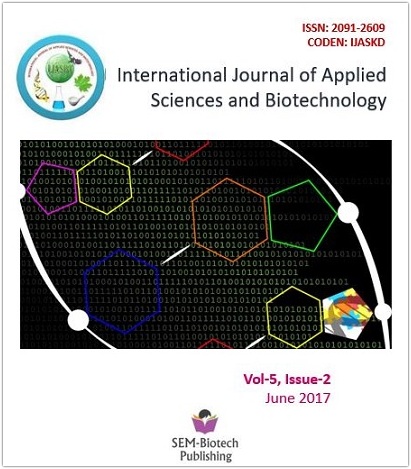Effect of Preceding Crops and Nitrogen Rates on Economic Studies of Winter Hybrid Maize (Zea mays L.)
DOI:
https://doi.org/10.3126/ijasbt.v5i2.17612Keywords:
Preceding crop, nitrogen rates, summer legumes, inclusion, crop sequence, production efficiencyAbstract
A field experiment was conducted at Agronomy research farm of IAAS, Rampur, chitwan, Nepal during summer and winter season 2010 and 2011 to study the effect of crop sequence and nitrogen rates on hybrid maize. The research finding revealed that maximum gross return (Rs 53660 /ha in 2010 and Rs 60450/ha in 2011) was obtained from maize grown after greengraml while maximum net return (Rs 30170/ha in 2010 and Rs 33440/ha in 2011) was obtained from maize under greengram-maize sequences. Benefit & cost ratio was maximum (1.22 in 2010 and 1.18 in 2011) from maize under greengram-maize sequences while it was minimum (0.50 in 2010 and 0.47 in 2011) under maize–maize sequences. Maximum maize equivalent yield 11516 kg /ha in 2010 and 12710 kg /ha in 2011) was obtained under maize-maize sequences while it was minimum (4310 kg /ha in 2010 and 4624 kg /ha in 2011) under clusterbean-maize sequences. Maize equivalent yield was maximum (10824 kg /ha in 2010 and 11923 kg /ha in 2011) with 200 kg N/ha while it was minimum (7384 kg /ha in 2010 and 8206 kg /ha in 2011) without nitrogen. Grain production efficiency was maximum (32.0 kg /ha/day under greengram– maize sequences in 2010. but in 2011, maximum grain production efficiency (34.8 kg /ha /day) was recorded under maize–maize sequences which was comparable to grain production efficiency under greengram-maize sequence. Maximum grain production efficiency (29.2 kg/ha/day in 2010 and 32.8 kg /ha/day in 2011) was obtained with 200 kg N/ha.
Int. J. Appl. Sci. Biotechnol. Vol 5(2): 180-187




